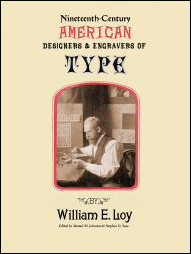 |
| New technology, such as electrotyping, the pantograph and router, introduced in the middle of the nineteenth century, combined with the expansion of commerce as America moved westward, created a great outpouring of exuberantly ornamented typefaces. Though these "Victorian" faces have moved in and out of favor, many of them have great charm and usefulness. They were produced in conditions of a commercial free-for-all, even outright piracy, not unlike the "desktop font" boom of the 1990s. While many Victorian types have been revived by digital foundries, their sheer number has intimidated historians unable to establish their true origins.
In 1896 William E. Loy, a San Francisco printing equipment salesman and scholar, had the idea of writing a series of profiles of type designers. Loy took a long view of history, and realized that it was important to document the men in the background who created the nineteenth century's fanciful types, even as the furiously competing type foundries got the credit for introducing them to the printing trade. His work was serialized in The Inland Printer over the next three years and included biographies, photographs of the artists, and lists of the type they had designed or cut, which Loy had painstakingly compiled through correspondence with the type founders and other craftsmen. Unfortunately, due to the technical limitations of a monthly periodical, it was not possible to show the typefaces mentioned. Finally here is the work as Loy envisioned it, with over 800 illustrations of typefaces designed by the craftsmen he discusses.
Here, written by a man who knew many of the designers and engravers, is the behind-the-scenes story: biographies of men - artists, sportsmen, blacksmiths, soldiers, even a game warden - who were the creators of these innovative types. Loy traces their personal stories adding much incidental detail about the politics & business practices of the time and the innovations of each of these thirty men. Now, a century later, typographical historians Alastair Johnston and Stephen Saxe have realized Loy's vision, fully illustrated and annotated. This is one of the first reference books on nineteenth-century American type design, and as such is an important addition to typographical history.
William E. Loy (1847-1906) grew up in the Midwest and moved to California in 1874. He worked as a newspaperman, printer and printing equipment salesman. He was associated with Nelson Crocker Hawks at the Pacific Type Foundry in San Francisco, before branching out on his own. His vast typographical library formed the core of the Kemble Collection now at the California Historical Society.
Stephen O. Saxe is the author of American Iron Hand Presses (Oak Knoll & The British Library, 1995); he annotated the revised edition of Annenberg's Typefoundries of America and their Catalogs (Oak Knoll & The British Library, 2000). A graduate of Harvard and Yale, he was a stage and television scenic designer before he became interested in printing history. Alastair Johnston is the author of Alphabets to Order: the Literature of Nineteenth-Century Typefounders' Specimens (Oak Knoll & The British Library, 2000). A co-founder of Poltroon Press, he has taught at the University of California since 1979. He also teaches book arts in public elementary schools. He is currently writing a biography of Richard Austin, the English type cutter, and his son the wood-engraver.
Price |
|
|
|


